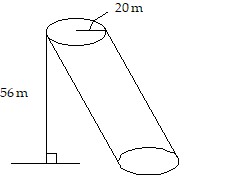Solve the equation.log (x - 9) = 1 - log x
A. -10
B. -1, 10
C. 10
D. -10, 1
Answer: C
You might also like to view...
Place your graphing calculator in parametric and degree modes. Set the window for Tmin=0, Tmax=360, Tstep=1, Xmin= -1.8, Xmax=1.8, Xscl=1, Ymin= -1.2, Ymax=1.2, Yscl=1. Set the functions to X1T=cos T, Y1T=sin T. Graph the circle of radius 1 on the screen. Use the trace feature to move a short distance around the circle.For what angle T is cos T ? 0.766? (Assume 0° ? T ? 90°.)
A. 40° B. 36.832° C. 50° D. 0.766°
Find the volume of the circular cylinder. Use 3.14 or  for ? as indicated.Use
for ? as indicated.Use  for ?.
for ?.
A. 197,120 m3
B.
| 70,400 m3 |
C. 281,600 m3
D. 3520 m3
Al-Khwârizmî solved the equation.
?
Here is a translation of his solution:
?
. . . a square and 10 roots are equal to 39 units. The question therefore in this type of equation is about as follows: What is the square which combined with ten of its roots will give a sum total of 39? The manner of solving this type of equation is to take one-half of the roots just mentioned. Now the roots in the problem before us are 10. Therefore take 5, which multiplied by itself gives 25, an amount which you add to 39 giving 64. Having taken then the square root of this which is 8, subtract from it half the roots, 5, leaving 3. The number three therefore represents one root of this square, which itself, of course is 9. Nine therefore gives the square.
?
Follow these directions to solve the equation.
?
What will be an ideal response?
Use mathematical induction to prove the sum formula for the indicated sequence. It is to hold for all positive integers m.

What will be an ideal response?

